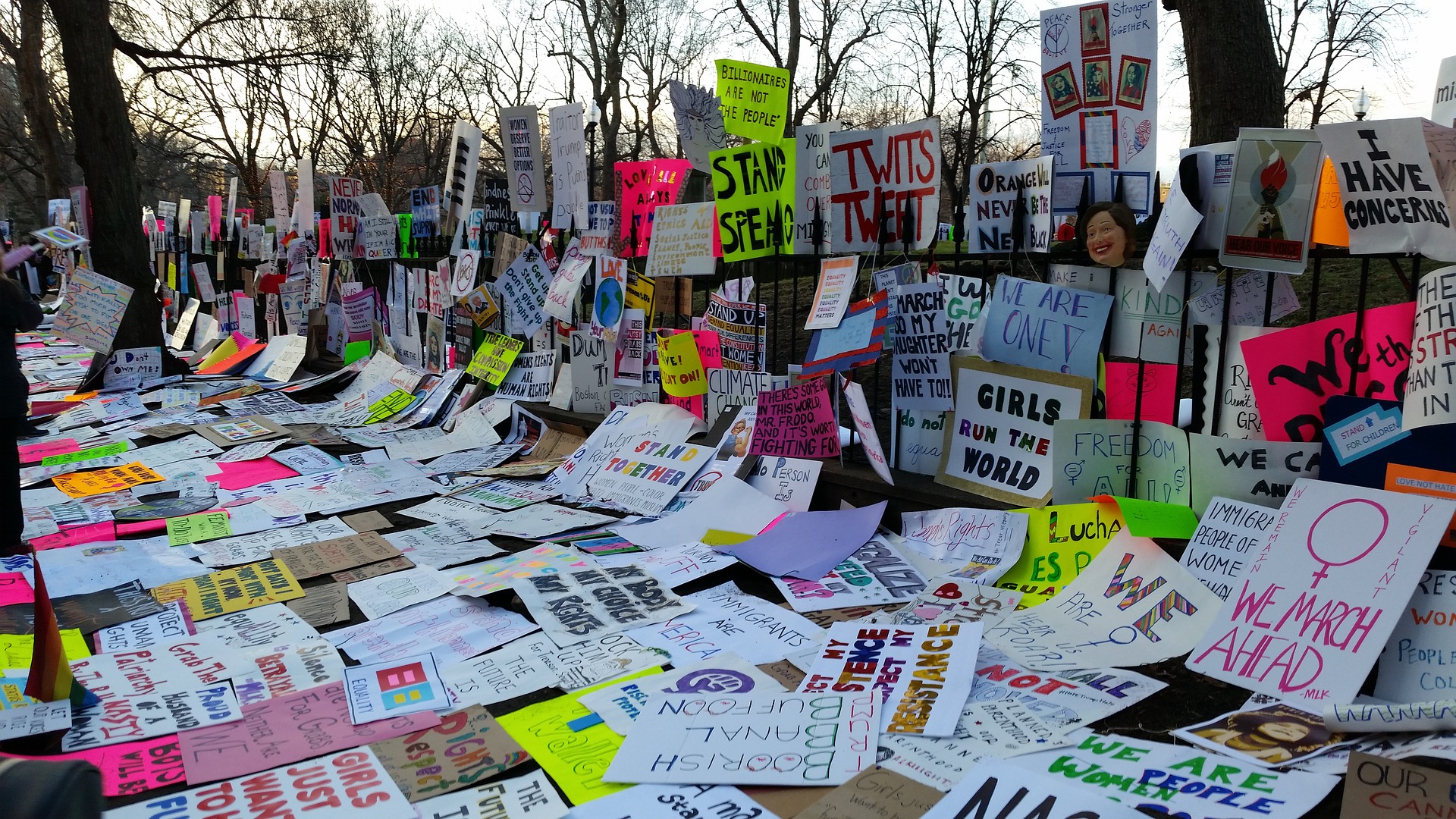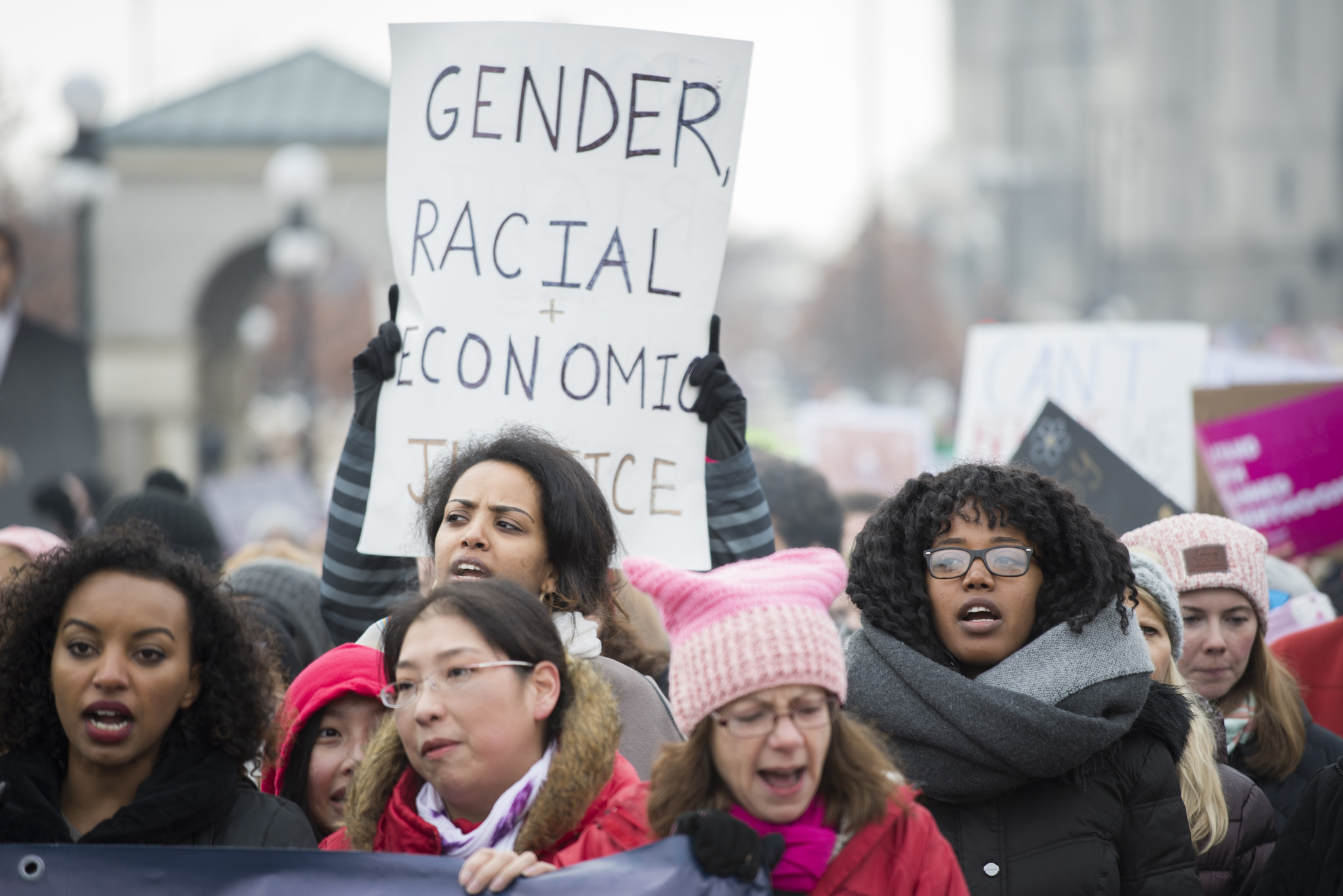

Elliot Tetreault, University at Albany, SUNY
The January 2017 Women's March on Washington has been called possibly the largest protest in U.S. history, with sister marches in many U.S. cities and internationally on every continent including Antarctica (Vick, 2017). The marches, which took place the day after the inauguration of Donald Trump as the 45th President of the United States, represented an uprising against the systemic, interconnected oppressions crystallized in the form of Trump's election. They have since given rise to not just a protest but a movement, under the banner of the Women's March and interconnected organizations. Far from being a homogenous movement, the Women's March and its aftermath have struggled with many of the tensions inherent in forming coalitions against multiple forms of oppression. The Women's March's policy platform has been called “beautifully intersectional” by some (Vagianos, 2017), but the march and resulting movement have also had to contend with legacies of white privilege, erasure of women of color and transgender women, and other histories of oppression in feminist movements.
In response to decades of “white feminism” and the stark statistic that 53% of white women voted for Trump while 94% of Black women voted against him (Beckett, Carroll, Fishwick, Jamieson, & Thielman, 2016), the Women's March movement has striven to enact intersectional principles and include women of color in its platform and messaging. This commitment to intersectionality can be most readily seen in the Women's March Unity Principles (2017) policy platform, framed on the web site with the statement, “We must create a society in which women—including Black women, Native women, poor women, immigrant women, disabled women, Muslim women, lesbian queer and trans women—are free and able to care for and nurture their families, however they are formed, in safe and healthy environments free from structural impediments.” Media outlets from NPR to the New York Times, Huffington Post, Vox, and USA Today featured coverage of the march that explicitly invoked intersectionality and grappled with its complexity while also advocating for its importance; on the other hand, some coverage also reinforced decades-old tendencies to misguidedly condemn intersectionality as divisive.
Some of the tensions within the Women’s March are best illustrated by one image that circulated widely after the march. It features Angela Peoples, activist and co-director of the LGBTQ equality organization GetEqual. Peoples, a black woman wearing a hat that says “Stop killing black people,” is in the foreground looking to the side while casually eating a lollipop, with a sign that says “Don’t forget: White women voted for Trump.” Directly behind Peoples, there are three white women standing on a wall, all wearing pink “pussyhats” and all on their smartphones, with one of them taking a selfie and smiling widely.
Woman in Viral Photo From Women's March to White Female Allies: "Listen to a Black Woman"
Angela Peoples did not come to the Women's March on Washington to play. The 30-year-old co-director of the LGBTQ equality organization GetEqual came to Saturday's massive protest against Donald Trump to tell the truth. Marching in a sea of white women, Peoples wore a hat that read, "Stop Killing Black People," and carried a sign that read in part, "White Women Voted for Trump."
The image, taken by Peoples’ boyfriend Kevin Banatte, went viral online after the march. Asked about reactions to the sign, Peoples responded in an interview:
[The photo] tells the story of white women in this moment wanting to just show up in a very superficial way and not wanting to do the hard work of making change, of challenging their own privilege. You’re here protesting, but don’t forget: The folks that you live with every single day—and probably some of the women that decided to come to the march—voted for Trump, made the decision to vote against self-interests to maintain their white supremacist way of life. (qtd in Obie, 2017)
Peoples also spoke about how the image captures ongoing white privilege in mainstream feminism: “I know that a lot of the organizers, particularly of the D.C. march, did a lot of work to make sure that the speakers were diverse, that the issue points reflected black folks’ experiences; but there’s also this reality that when we talk about feminism in this country, the faces have been white. Without an effort by white women especially to make sure those spaces are reflecting the diversity of women and femme people, we’re not going to make the progress we need to” (qtd in Obie, 2017). As the image spread virally, commentators used it as a symbol for the conversations feminists need to have about erasures and violences against women of color. An article in USA Today describes the photo as “quietly tell[ing] a powerful story about the cracks in America's feminist movement” (Dastagir, 2017), and The New York Times asserts that the photo “cuts to a truth of the [2016] election: While black women show up for white women to advance causes that benefit entire movements, the reciprocity is rarely shown” (Wortham, 2017).

Image by Fibonacci Blue, used under a CC BY 2.0 license
Scholars of activist rhetorics will likely be researching events such as the Women’s March on Washington for a long time, so we need ways to do this that refuse to continue feminist histories of exclusion and that commit instead to a more just and equitable feminist future for those historically wounded. In addition, specifically for the renewed study of technofeminist rhetorics, the Women's March represents a productive site of research as a continually unfolding material and digital rhetorical action. I begin from the above photograph of Angela Peoples and its viral circulation as what Pamela Takayoshi (2000) called "a heuristic for further investigation" (p. 132) rather than an essentializing claim about women and technology use. Specifically, the image of Peoples as an unfolding digital rhetorical action offers an opportunity for technofeminist rhetoricians to more deeply consider questions of intersectionality and accountability in the study of digitally circulating feminist rhetorical actions.
Just as digital rhetoric has moved toward exploring circulation and movement rather than treating online spaces as static and bounded (see Gries, 2015), technofeminist rhetorical research can also be enriched by studying dynamic and evolving examples of complex, networked rhetorical action such as the Women's March. Technofeminist researchers have by now long recognized that digital spaces can reproduce inequities in addition to disrupting them (Selfe, 1999), and have cautioned against constructing any essentializing narrative of women, technology, or the relationship between these terms (Takayoshi, 2000). However, this contemporary context offers an opportunity for technofeminist research to create additional, ever-complexifying narratives of digital feminist activism, or as Jacqueline Jones Royster and Gesa Kirsch (2012) wrote, to not only critique the "contexts, products, and processes" of digital spaces but to further study "the impacts and consequences of technologies on the scope, nature, and contours of [feminist] theoretical enterprises” (p. 150). This increasing complexity of digital rhetorics thus requires technofeminist theoretical and methodological innovations.
Studying complex, circulating digital rhetorical actions from a technofeminist lens also requires methodoogies that counter injustice and that refuse to reinforce exclusionary practices, or what Kristine Blair and Christine Tulley (2007) referred to as a "continued articulation of the powerful, yet complicated triangulation of feminist methodology, political action, and technological literacy" (p. 70). As I specifically focus on in this web text, women of color have been calling on feminists for decades to help build coalitions meant to improve the lives of all women, including queer and trans women of color (see brown, 2017; hooks, 1984; Lorde, 2007). Studying digital feminist rhetorics also offers an opportunity to center and amplify the experiences and innovations of women of color and to actively work against systemic racism, rather than implicitly reproducing it as is all too common when women of color are not centered in the discourse (Carey, 2018; Gutenson & Bachelor Robinson, 2016; Kynard, 2010). Those of us who analyze activist rhetorics from a position of privilege need to do this work while amplifying the strategies and voices of those who are multiply marginalized, but we cannot continue to place the work of enacting intersectional feminist praxes only on these communities, while ignoring the need for others such as white women to take on more of the responsibility. Thus, in this web text, I offer some ways forward for privileged allies to enact greater rhetorical awareness when studying technofeminist activist rhetorics across differences.
The rest of this web text is organized as follows: In the next section, I explore my positionality in relation to the Women's March and its circulation. Then, I outline a framework for disrupting white feminisms in the uptake of the Women's March. I apply this framework in the "Accountability" section by using accountability to vulnerable communities as a measure of efficacy for feminist rhetorics. Overall, I hope to use the Women's March as an occasion for thought for feminist rhetoricians about how we might work across differential axes of privilege and oppression to study the movement of protest rhetoric while maintaining accountability to vulnerable communities.